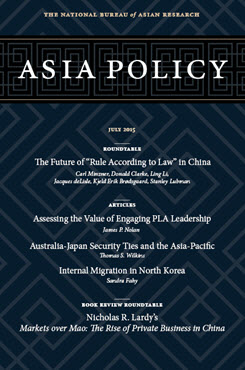Chinese Characteristics of the "Socialist Rule of Law"
Will the Fourth Plenum Cure the Problems of the Chinese Judicial System?
This essay is part of the roundtable “The Future of ‘Rule According to Law’ in China.”
Ling Li is a Senior Research Fellow at the U.S.-Asia Law Institute of New York University School of Law. She is also an Associate Professor at the Northwest University of Political Science and Law in China.
The Fourth Plenum of the 18th Party Congress has been characterized as a historical event at which the Chinese Communist Party (CCP) officially endorsed the rule of law (yifa zhiguo). But in fact, the term was first coined and already used in the work report delivered by Jiang Zemin, the then party general-secretary, at the 15th Party Congress in 1997. Described as a fundamental governing strategy of the CCP, the Chinese socialist rule of law is clearly distinguished from the supposedly capitalist rule of law as understood in the West. The most striking difference between the two resides in the matter of “judicial independence,” which is denied in China but essential for the Western concept of the rule of law. Judicial independence is denied in China because to establish it is to establish the court system as a competing authority, which would necessarily undermine the supremacy of the party’s authority over the state, rendering this practice incompatible with the party-state structure.
Instead, China’s courts are granted the authority to exercise “adjudicative independence” (shenpan duli). This authority has two aspects: first, courts can exercise judicial power “independently” without interference from other state institutions; and second, courts are authorized to challenge the legality of decisions of other state institutions within the realm of law. This arrangement is part of the institutional design of the party-state. Under the party’s supreme leadership, state power is divided into four branches: the legislative, the executive, the judiciary, and the procuratorates, among which a measure of checks and balances is installed. This structure is supposed to allow the party, the only authority that sits above the state, to generate concerted actions from different branches of the state based on the principle of the CCP’s leadership (i.e., rule of the party) on issues that are of primary importance to the party and require the party’s direct involvement in the decision-making process. It also allows the CCP to delegate decision-making power to state institutions and to have their powers checked by each other based on the principle of the rule of law on issues that are of secondary or little importance to the party and that do not require its direct involvement in decision-making. [1]
This essay aims to provide readers with the necessary context to enable a deeper understanding and more pertinent assessment of the Fourth Plenum. To that end, the first section explains the limitations of the Chinese judicial system and how these limitations are consequences of two structural defects inherent in the overall institutional design of the party-state. In the second section, I then show how the reform measures introduced at the Fourth Plenum respond to these structural defects.
Endnotes
[1] For more details about how the party regulates and participates in court affairs in China, see Ling Li, “The Chinese Communist Party and People’s Courts—Judicial Dependence in China,” American Journal of Comparative Law 64, no. 1 (forthcoming, 2016), https://nyu.academia.edu/LingLi.
About Asia Policy
Asia Policy is a peer-reviewed scholarly journal presenting policy-relevant academic research on the Asia-Pacific that draws clear and concise conclusions useful to today’s policymakers. Asia Policy is published quarterly in January, April, July, and October and accepts submissions on a rolling basis. Learn more


